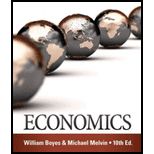
Economics:
10th Edition
ISBN: 9781285859460
Author: BOYES, William
Publisher: Cengage Learning
expand_more
expand_more
format_list_bulleted
Concept explainers
Question
Chapter 25, Problem 12E
To determine
To explain:
The pricing strategy of universities, assuming that universities are profit-maximizing monopolists.The reason for colleges and universities provide scholarships and aids to students.
Expert Solution & Answer
Want to see the full answer?
Check out a sample textbook solution
Students have asked these similar questions
Dear tutor, please solve these multiple questions. Thank You!
11. If the demand shifts, then for a profit maximizing monopolist, A) price will change while quantity will remain constant.B) price will change and quantity will change.C) Both A and B.D) Neither A nor B.
30. A monopolist will spend resources to advertise its product so long as A) net profits increase.B) gross profits increase.C) demand increases.D) total revenue increases.
32. What aspects of a game are specified by "the rules of the game"?
A) timing of players' movesB) payoffsC) information available to each playerD) All of the above
33. When neither player has a dominant strategy,
A) game theory will not provide information.B) no Nash-Equilibrium exists.C) at least one Nash-Equilibrium exists.D) the game cannot be analyzed.
Monopoly and Price Elasticity
Consider the relationship between monopoly pricing and the price elasticity of demand.
If demand is inelastic and a monopolist raises its price, quantity would fall by a (LARGER AND SMALLER) percentage than the rise in price, causing profit to (DECREASE OR INCREASE) . Therefore, a monopolist will (ALWAYS, NEVER OR SOMETIMES) produce a quantity at which the demand curve is elastic.
Use the purple segment (diamond symbols) to indicate the portion of the demand curve that is inelastic. (Hint: The answer is related to the marginal-revenue (MR) curve.) Then use the black point (plus symbol) to show the quantity and price that maximizes total revenue (TR).
Andrew Carnegie's monopoly in steel was never as complete as John D. Rockefeller's monopoly in oil. But even after the breakup of Standard Oil in 1914, monopolies kept developing -- including more "natural" monopolies such as Microsoft and Facebook. Why does the government of the USA continue to attempt to break up monopolies? What is the economic rationale?
A. Monpolies are inherently anti-consumer.
B. Monpolies are a natural consequence of technoogical innovation, and are seen by some economists as evidence of the superiority of capitalism because the market rewards competition.
C. Monopolies are problematic because of price-fixing, which is achieved mainly after they become established, not because of the aggressive competition required to out-compete rivals before market dominance is achieved.
D. All the above.
Knowledge Booster
Learn more about
Need a deep-dive on the concept behind this application? Look no further. Learn more about this topic, economics and related others by exploring similar questions and additional content below.Recommended textbooks for you

 Economics: Private and Public Choice (MindTap Cou...EconomicsISBN:9781305506725Author:James D. Gwartney, Richard L. Stroup, Russell S. Sobel, David A. MacphersonPublisher:Cengage Learning
Economics: Private and Public Choice (MindTap Cou...EconomicsISBN:9781305506725Author:James D. Gwartney, Richard L. Stroup, Russell S. Sobel, David A. MacphersonPublisher:Cengage Learning Microeconomics: Private and Public Choice (MindTa...EconomicsISBN:9781305506893Author:James D. Gwartney, Richard L. Stroup, Russell S. Sobel, David A. MacphersonPublisher:Cengage Learning
Microeconomics: Private and Public Choice (MindTa...EconomicsISBN:9781305506893Author:James D. Gwartney, Richard L. Stroup, Russell S. Sobel, David A. MacphersonPublisher:Cengage Learning Managerial Economics: A Problem Solving ApproachEconomicsISBN:9781337106665Author:Luke M. Froeb, Brian T. McCann, Michael R. Ward, Mike ShorPublisher:Cengage Learning
Managerial Economics: A Problem Solving ApproachEconomicsISBN:9781337106665Author:Luke M. Froeb, Brian T. McCann, Michael R. Ward, Mike ShorPublisher:Cengage Learning


Economics: Private and Public Choice (MindTap Cou...
Economics
ISBN:9781305506725
Author:James D. Gwartney, Richard L. Stroup, Russell S. Sobel, David A. Macpherson
Publisher:Cengage Learning

Microeconomics: Private and Public Choice (MindTa...
Economics
ISBN:9781305506893
Author:James D. Gwartney, Richard L. Stroup, Russell S. Sobel, David A. Macpherson
Publisher:Cengage Learning


Managerial Economics: A Problem Solving Approach
Economics
ISBN:9781337106665
Author:Luke M. Froeb, Brian T. McCann, Michael R. Ward, Mike Shor
Publisher:Cengage Learning
